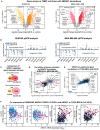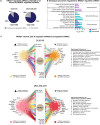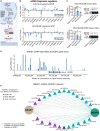LncRNA NRAD1 regulates the triple-negative breast cancer transcriptome by miRNA biogenesis, localization, and predominately non-ceRNA interactions
- PMID: 40696096
- PMCID: PMC12284168
- DOI: 10.1038/s41598-025-12415-7
LncRNA NRAD1 regulates the triple-negative breast cancer transcriptome by miRNA biogenesis, localization, and predominately non-ceRNA interactions
Abstract
Breast cancer is a leading cause of cancer mortality in women with triple-negative breast cancer (TNBC) presenting greater treatment challenges due to its aggressive disease progression. Understanding TNBC's unique cell signaling and gene expression profiles will reveal novel therapeutic strategies. Non-coding RNAs, including microRNAs (miRNAs) and long non-coding RNAs (lncRNAs), have emerged as key regulators of gene expression and potential therapeutic targets. This study focuses on a TNBC-enriched lncRNA, non-coding RNA in the aldehyde dehydrogenase 1A pathway (NRAD1, previously LINC00284), which promotes progression in multiple cancers. Our analysis reveals that NRAD1 is central to miRNA-mRNA networks in TNBC cells, mediating cancer-promoting gene expression changes. Fractionation studies showed that NRAD1 is primarily located in the nucleus and mitochondria, with some cytoplasmic presence allowing for transcript-specific competitive endogenous RNA (ceRNA) interactions with miRNAs. However, NRAD1 primarily effects miRNAs independently of ceRNA activity, instead upregulating DICER (a miRNA biogenesis protein), altering sub-cellular distribution, and reducing biogenesis of mitochondria-localized miRNA (i.e., miR-4485-3p). These findings demonstrate novel regulatory interactions between the cancer-promoting lncRNA NRAD1 and miRNAs that alter gene expression in TNBC, expanding our understanding of regulatory lncRNA-miRNA effects, TNBC biology, and highlighting future therapeutic strategies for targeting non-coding RNAs.
Keywords: Breast cancer; Gene-expression; LINC00284; Long non-coding RNA; NRAD1; Triple-negative; microRNA.
© 2025. The Author(s).
Conflict of interest statement
Competing interests: J.V., M.C.D.W, and P.M. are co-founders of Oncolinc Therapeutics Inc., a startup aimed at developing targeted therapies against lncRNAs as novel immunotherapies. P.M. is also a co-founder of Theranib Inc. a startup aimed at developing small molecule drugs targeting ALDH1A3 for the treatment of cancer. H.F.C., J.M.B., M.L.T.,R.P.A.,M.E.M.,and D.V have no competing interests.
Figures







Similar articles
-
Multifaceted interactions between lncRNA-associated ceRNA networks and small molecules in triple-negative breast cancer.Biomed Pharmacother. 2025 Aug;189:118241. doi: 10.1016/j.biopha.2025.118241. Epub 2025 Jun 16. Biomed Pharmacother. 2025. PMID: 40527037 Review.
-
A novel long non-coding RNA MIR4500HG003 promotes tumor metastasis through miR-483-3p-MMP9 axis in triple-negative breast cancer.Cell Death Dis. 2024 May 2;15(5):310. doi: 10.1038/s41419-024-06675-w. Cell Death Dis. 2024. PMID: 38697967 Free PMC article.
-
ALDH1A3-regulated long non-coding RNA NRAD1 is a potential novel target for triple-negative breast tumors and cancer stem cells.Cell Death Differ. 2020 Jan;27(1):363-378. doi: 10.1038/s41418-019-0362-1. Epub 2019 Jun 13. Cell Death Differ. 2020. PMID: 31197235 Free PMC article.
-
Identification of a LncRNA based CeRNA network signature to establish a prognostic model and explore potential therapeutic targets in gastric cancer.Sci Rep. 2025 Jul 1;15(1):20891. doi: 10.1038/s41598-025-05105-x. Sci Rep. 2025. PMID: 40595924 Free PMC article.
-
NUTM2A-AS1 as a potential key regulator in cancer: unraveling its ceRNA networks and impact on tumor biology.Eur J Med Res. 2025 Sep 3;30(1):840. doi: 10.1186/s40001-025-03019-y. Eur J Med Res. 2025. PMID: 40903777 Free PMC article. Review.
References
-
- Waks, A. G. & Winer, E. P. Breast cancer treatment: A review. JAMA J. Am. Med. Assoc.321, 288–300 (2019). - PubMed
-
- Bianchini, G., De Angelis, C., Licata, L. & Gianni, L. Treatment landscape of triple-negative breast cancer—expanded options, evolving needs. Nat. Rev. Clin. Oncol.19, 91–113 (2021). - PubMed
MeSH terms
Substances
Grants and funding
LinkOut - more resources
Full Text Sources

